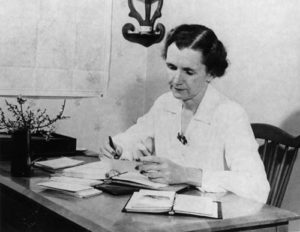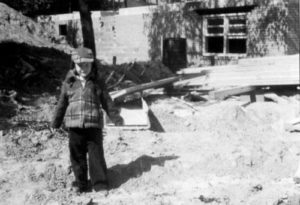 In Silent Spring’s acknowledgements, Rachel Carson expressed her gratitude to Ida Sprow – an African-American woman who played an important, yet often unheralded, role in the making of this landmark environmental book. As Rachel explained, she
In Silent Spring’s acknowledgements, Rachel Carson expressed her gratitude to Ida Sprow – an African-American woman who played an important, yet often unheralded, role in the making of this landmark environmental book. As Rachel explained, she
“could not possibly have completed the task, under circumstances sometimes difficult, except for the faithful help of my housekeeper, Ida Sprow.” [1]
While Rachel researched and wrote Silent Spring, she did face difficult circumstances: her elderly mother’s health was declining (Maria Carson passed away late in 1958), her young grandnephew and adopted son Roger required looking after, and Rachel’s own battle with breast cancer was intensifying. Not to mention Rachel’s admitted lack of skill in housework and cooking. [2] Ida helped her overcome these challenges by cleaning the house [3], preparing meals [4], doing laundry [5], accompanying her on errands [6], packing the car for her trips to Maine [7], addressing her family members’ needs [8], running the household after Maria’s death [9], and supporting Rachel herself in her final illness right up to the moment she passed away in her bedroom at home on Berwick Road on 14 April 1964 [10] – all of which allowed Rachel to focus on what would become Silent Spring and the resulting chemical industry pushback.
Rachel respected Ida for the special qualities that she brought to the Carson household. As young Roger was convalescing from the flu in late October 1958, Rachel wrote to friend Dorothy, “with Ida here all is serene.” (Always, Rachel, p. 269). Like Rachel, Ida appears to have had an appreciation for nature. While sources reflecting Ida’s perspective are sparse, the historical record does offer three glimpses of Ida’s life that point to her own abiding interest in animals and familiarity with the natural world.
 First, both Ida and Rachel had grown up in rural settings before moving to the Washington, D.C. area. Born to William and Ellen Key [11] on 2 January 1920 [12], Ida spent her early years on the farm her family owned in Fluvanna County, Virginia. [13] In the 1930s, she joined the Great Migration, moving to Washington, D.C. to lodge at a boarding house with two of her sisters, all working as maids. [14] On 28 September 1940 [15], she married Charles Sprow. In due course, he served in World War ll [16] then became an interstate truck driver [17] and together they raised son Raymond. [18] As she made her way in the city, Ida carried her firsthand experience of rural Virginia farm life with her.
First, both Ida and Rachel had grown up in rural settings before moving to the Washington, D.C. area. Born to William and Ellen Key [11] on 2 January 1920 [12], Ida spent her early years on the farm her family owned in Fluvanna County, Virginia. [13] In the 1930s, she joined the Great Migration, moving to Washington, D.C. to lodge at a boarding house with two of her sisters, all working as maids. [14] On 28 September 1940 [15], she married Charles Sprow. In due course, he served in World War ll [16] then became an interstate truck driver [17] and together they raised son Raymond. [18] As she made her way in the city, Ida carried her firsthand experience of rural Virginia farm life with her.
Second, Ida seems to have shared Rachel’s love of animals – a fact that Rachel took note of when she interviewed Ida in November, 1956. During the interview, Rachel’s cat, Jeffie, had jumped into Ida’s lap, but Ida did not object to this furry interruption. [19] Later, when Rachel was hospitalized for radiation treatments and physical therapy, Ida would tend to her beloved cats and report to Rachel how they were faring in her absence. [20]
Third, as Rachel advocated, Ida imparted her “sense of wonder” to the next generation. For example, there was the time young Roger picked up a chickadee he had found in the snow while Rachel was being taken to the hospital by ambulance in February 1961. With Rachel unavailable, it was Ida who helped Roger administer fluids to the fluttering bird, then placing it in a box on the porch, feeding it seeds and peanuts, and ultimately releasing it back into the wild. [21]
By 1963, Ida was also assisting Rachel in sorting through materials she had used to write her books on the sea in preparation for leaving them to a repository for the use of future researchers. [22]
Despite their apparent common interest in animals and nature, Rachel and Ida had led very different lives. As an African-American, Ida’s opportunities had been limited by a segregated grade school education [23] and career options that did not extend much beyond maid (a position held by 54.4% of working black women in 1940 [24]). Ida faced racial prejudice even as some legalized racial barriers were starting to lift in D.C. [25]; a long commute from her Capitol Hill home to Rachel’s house in Silver Spring, Maryland via streetcar [26], bus [27], or ride from her husband [28] (Ida herself did not drive [29]); as well as a family of her own to care for – presumably without the help of a housekeeper. Sometimes Ida had to stand up to Rachel, explaining that because of her family obligations she could not stay overnight as Rachel wanted her to do occasionally [30] (although she did make exceptions, taking on “night duty” every now and then [31]).
As a result of these differences, Ida’s behind-the-scenes contribution to Silent Spring is often unsung. But Rachel did not forget as she penned her book’s acknowledgements….or as she posed with Ida for Life magazine photographer Alfred Eisenstaedt….or as she left a cash bequest to Ida in her last will and testament. [32] So as we commemorate the 58th anniversary of this environmental classic, let’s join her in honoring Ida Sprow, the woman without whom Rachel
“could not possibly have completed the task.”
By Sylvia Dove
Footnotes:
[1] Rachel Carson, Silent Spring
[2] Always, Rachel, p.28
[3] Linda Lear, Rachel Carson: Witness for Nature, pp. 294-95
[4] Always Rachel, p. 470
[5] Linda Lear, Rachel Carson: Witness for Nature, pp. 294-95
[6] Always Rachel, p. 470
[7] Always Rachel, p. 261
[8] Always Rachel, p. 345
[9] Linda Lear, Rachel Carson: Witness for Nature, p. 363
[10] Linda Lear, Rachel Carson: Witness for Nature, p. 583, footnote 79
[11] 1930 U.S. Census
[12] Index Record for Ida B. Sprow, Social Security Death Index, https://www.fold3.com/record/284862032-ida-b-sprow
[13] 1930 U.S. Census
[14] 1940 U.S. Census
[15] Ancestry.com. District of Columbia, Marriage Records, 1810-1953 [database on-line]. Lehi, UT, USA: Ancestry.com Operations, Inc.,2016. Original Data: Marriage Records. . District of Columbia Marriages. Clerk of the Superior Court, Records Office, Washington D.C.
[16] Index Record for Charles W. Sprow, WWII Army Enlistment Records (Source Box Number 0725, Source Film Reel Number: 1.242), https://www.fold3.com/record/87552584-charles-w-sprow (accessed 21 May 2020)
[17] Always Rachel, p. 209
[18] Raymond Key in the U.S. Public Records Index, 1950-1993, Volume 1 (Ancestry.com. U.S. Public Records Index, 1950-1993, Volume 1 [database on-line]. Provo, UT, USA: Ancestry.com Operations, Inc., 2010).
[19] Linda Lear, Rachel Carson: Witness for Nature, pp. 294-95
[20] Martha Freeman, Always Rachel, pp. 346, 347
[21] Martha Freeman, Always Rachel, p. 345
[22] Linda Lear, Rachel Carson: Witness for Nature, p. 468
[23] 1930 U.S. Census; 1940 U.S. Census; Thomas Jefferson Planning District Commission, Virginia Department of Historic Resources, Architectural History Identification and Assessment of Fluvanna County, Va. (1993), https://www.dhr.virginia.gov/pdf_files/SpecialCollections/FV-006_AH_ID_Survey_Fluvanna_County_1993_TJPDC_report.pdf
[24] Bonnie Thornton Dill, Across the Boundaries of Race and Class: An Exploration of Work and Family Among Black Female Domestic Servants, Garland Publishing (1994), p.16
[25] Joan Quigley, Just Another Southern Town: Mary Church Terrell and the Struggle for Racial Justice in the Nation’s Capital, Oxford University Press (2016), p.227.
[26] Martha Freeman, Always Rachel, pp. 317-18
[27] Linda Lear, Rachel Carson: Witness for Nature, pp.294-95; Always Rachel, p. 416
[28] Always Rachel, p. 338
[29] Always Rachel, p. 359
[30] Always Rachel, pp. 208-09, 466; Linda Lear, Rachel Carson: Witness for Nature, pp. 294-95, 541
[31] Always Rachel, p. 407
[32] Linda Lear, Rachel Carson: Witness for Nature, p.477



